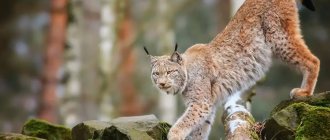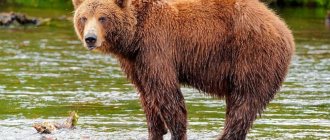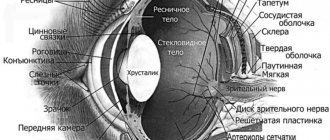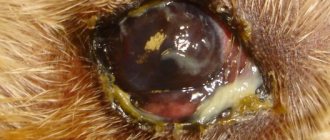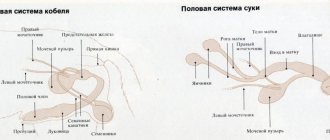The turtle in nature is a representative of the most ancient inhabitants of the planet; the uniqueness of the animal lies in the unusual design of the skeleton, in which the skeletal system is connected to a hard protective shell in the form of a shell. The turtle's shell protects it from the negative influences of the surrounding world and makes it one of the slowest animals on the planet.
In total there are more than 200 species of turtles. Most of them are light in weight and reach several tens of centimeters in length. The weight of large species reaches 700-900 kg, with the main weight concentrated on the shell. The smallest variety weighs 100-200 g. Turtles can live both in the wild and at home. You can learn a lot of useful information about pet turtles here.
Turtle: description, characteristics
- Different species are adapted to their habitat - some prefer water, others live on land. Aquatic reptiles are predators. Their diet includes fish, shellfish, and invertebrates. In nature, the land turtle feeds primarily on plant foods.
- Turtles are long-lived . The average life expectancy is 150-200 years. These animals have inhabited planet Earth for more than 200 million years. In addition to bone shelter from adverse factors, nature has endowed turtles with good eyesight and excellent hearing. When cold weather sets in, turtles go into hibernation.
Elephant
Differences in the diet of small and adult individuals
- Small turtles feed 2-3 times a day, adults – 1 time.
- Young animals need more calcium and vitamin D. Feed your pets food mixed with bone meal and mineral and vitamin supplements. Serve these mixtures daily. Adult turtles only need calcium once a week.
- Young turtles can go without food for a week, and older reptiles can go without food for 2 weeks.
- Turtles are more sensitive to monotonous food. Provide them with as varied a diet as possible.
- It is correct to feed turtles with food particles no larger than a blueberry. For adult turtles, a piece of food should not exceed half the size of its head.
The benefits of turtles in nature
- In nature, the turtle is a natural link in the food chain. In ancient times and in the modern food industry, turtle meat is used for cooking.
- Turtle shell is used for decorative purposes and in jewelry production. The symbolism of turtles is used in mythology, art, and heraldry.
- Turtles are representatives of the oldest species of animals and record holders for longevity. Unique animals deserve human care.
Turtle body structure
- Turtles have very well developed limb muscles. The mammal travels long distances on its 4 legs, carrying a huge heavy shell.
- The animal's head has a streamlined shape for comfortable camouflage inside the shell. In most varieties, the eyes are located on the sides of the head and directed towards the bottom. Food absorption occurs with the help of a hard front beak.
- In land turtles, the forelimbs are adapted for digging, and the hind legs allow them to push a heavy shell forward. In freshwater species, dense membranes are formed on the paws, connecting the toes into fins. Movement in water occurs mainly with the front paws, so their size is significantly larger than the hind paws.
- All types of turtles have a small , pointed tail. Several exotic species have a conical spine at the tip. The cervical and caudal sections of the spine are movable, the rest of the skeleton is connected to the shell.
Structure
Origin of the name
If we consider the Slavic and Latin origins of the name of the reptile, it is easy to see the commonality. Both languages demonstrate a response to appearance in the word: translated from Latin “tile”, “clay vessel”, “brick”; from Slavic - “shard”.
Indeed, many turtles resemble the stone for which the people who gave them this name mistook them. Despite this etymology of the name, it also contains an indication of the unique shape and color of the hard shells.
What does a turtle without a shell look like and what is it made of?
- Another unique feature of the turtle is the presence of an internal and external skeleton. The turtle's shell is tightly fused with the ribs and vertebrae; without it, the animal's life is not possible. The presence of a bone structure limits the development of the trunk muscles.
- The thoracic region is lined with oblong vertebrae that pass into the sternum. 33 vertebrae in the turtle's tail , which provide it with mobility. The hip bones are very short and are an integral part of the frame and spine.
- The freshwater turtle is found in nature with a frame made of soft tissues covered with rough skin. Relatively light weight facilitates rapid movement and performs protective functions when encountering danger.
Without a shell
turtle shell
- The main feature in the structure of turtles is the shell. The abdominal frame has a flat shape. The bone formation located along the spine has the shape of a semicircle. The upper and lower parts of the shell are connected to each other by bone membranes.
- The surface of the shell is covered with horny scales. Its strength can withstand a load exceeding 200 times the weight of a turtle. The scales of the shell and the rough skin of the body are renewed during the molting process.
- The shell is a reliable shelter . At the slightest threat, the mammal easily transforms the soft parts of the body and hides them under a bone capsule. The neck muscles allow you to completely pull your head inward, leaving only pinholes for breathing outside.
- Any mechanical damage to the shell in the form of abrasions or cracks can provoke a fungal disease. Therefore, despite their external invulnerability, turtles must be handled very carefully.
- Along with its protective functions, a tortoise shell helps to retain heat. Blood vessels pass through it. Due to the many nerve endings, the turtle is able to feel pain and discomfort when mechanically applied to the bone plate.
Shell and skeleton
Caring for your turtle
The first thing you should pay attention to when purchasing a pet is its appearance and size. A turtle that is under 5 cm in size at the time of purchase will be very difficult to raise.
At this age, small individuals are susceptible to various infections and diseases. This is how natural selection takes place. Therefore, a turtle 5–7 cm in size will be the best choice when purchasing.
You should also carefully examine the color of the shell. The claws and tail must be intact. The skin looks healthy and the eyes shine. After the pet is in the aquarium, watch how it swims. A healthy turtle should swim smoothly, without leaning in different directions.
Healthy turtle
Features of treatment
After purchasing a pet and moving it into an aquarium, it may go through an adaptation period. Typically it will take 2 to 5 days. At this time, the animal becomes a little inhibited, or, conversely, very active. There is no need to panic and pick up the animal. Give him peace and time to adapt to new conditions. After a while, the turtle will get used to the new environment and become calmer.
When trying to pick up a turtle, do it very carefully and always with both hands. Not all representatives are willing to make contact. Some may flounder, hiss, and defecate in fear. The shell becomes slippery in water; keep this fact in mind when removing your pet from the aquarium.
After you hold the turtle in your hands, be sure to wash them with soap. Despite being kept clean, turtles are often carriers of salmonellosis. To avoid the spread of infection, you must always monitor the condition of the aquarium and the quality of the food.
Does a turtle have teeth and how many?
- The turtle has no teeth. Chewing food is carried out using horny plates covering the inside of the mouth and pharynx. The textured coating easily handles hard products and grinds plant tubers and stems.
- Excessive salivation contributes to the formation of food lumps, which can remain in the mouth and esophagus for a long time. Promotion of food is carried out using a massive tongue. The limited functionality of the tongue does not allow it to stick out of the mouth.
- In some species of turtles, the tongue is covered with taste buds. Varieties that do not feel taste are less picky about food. Digestion of one turtle meal can take about a week. The functioning of the digestive tract depends on temperature conditions.
Without teeth
Dangerous products
We now know what different types of turtles eat. But still, some owners share food with their pets that may be dangerous for the animals.
The following foods should never be given to any turtles:
- Beef, pork, lamb and their derivatives (sausage, frankfurters, pate, minced meat),
- Cheeses and dairy products,
- Bakery products,
- Potato,
- Corn,
- Citruses,
- Feed intended for other animals.
All of these foods can impair the well-being and health of pet reptiles. Dangerous plants for reptiles include azaleas, dieffenbachias, oleanders, elodeas and euphorbias .
How does a turtle breathe?
- The turtle breathes through its nasal passages. The openings of the nose are easily visible on the front of the head. Some varieties have a small elongated proboscis.
- Turtles do not have a rib cage , so the voluminous lungs fill the entire upper part of the space under the semicircular shell. The heavier the bone armor, the larger the lung capacity. When inhaling, muscle ligaments and pulmonary muscles contract in the turtle’s body.
- The turtle's breathing is measured. Its frequency depends on the living conditions of the mammal. Freshwater and sea turtles can survive without air for several hours, after which they need to come to the surface of the water and get a new portion of oxygen. Land mammals take about 5 breaths per minute.
- Several species of sea turtles use alternative methods of breathing - through the surface of the skin or special sinuses in the respiratory system. The structural features of the mammalian respiratory system exclude reflex coughing or sneezing. Retention of mucus in the respiratory tract often leads to the development of pneumonia.
How to determine the sex of a turtle?
Sexual differences in turtles can only be noticed upon careful examination. External differences between male and female mammals include:
- Shell shape. In females, the shell is elongated into an oblong shape; in males, the shape is more like a flattened oval.
- Plastron shape. On the lower part of the shell, on the side of the tail, males have a depression that facilitates the process of reproduction. In females in this area the plastron is flat.
- Tail length. The tail of female mammals is elongated and straight. Males have a longer tail and more massive at the base.
- Location of the cloaca. In females, the anus is located at the base of the tail and has a rounded shape. In males, the cloaca, in the shape of an elongated seed, is located in the lower third of the tail.
- Nail length. Males have much longer nails on their front paws than females. This feature is a convenient tool for mating.
Determination of gender
Where do turtles live in nature?
- Marine species of turtles live in seas and oceans. Heat-loving animals prefer tropical and temperate climates. The animal cannot survive on cold continents, so it chooses areas with warm open currents and coastal waters. To access air, sea turtles stay close to the surface of the water and often become a catch for people.
- Land turtles prefer areas with arid climates. Animals inhabit desert and steppe lands in southern Europe, Australia, America, and Africa . Several species live in tropical rainforests. In mountainous areas you can meet a turtle at an altitude of 1-1.5 km. There are about 60 species of land reptiles.
- Freshwater turtles live in Europe and Asia near various freshwater bodies. Small rivers, lakes, and seasonal reservoirs are preferable. Freshwater turtles in Russia are found naturally in the regions of the North Caucasus.
- The unusual red-eared turtle is found naturally in North and South America. In Italy they are considered plant pests. You can learn more about the red-eared slider here.
- The snapping turtle , which can bite humans, is found in Canada and the United States. The large green turtle lives in the seas of the Pacific and Atlantic oceans.
Kinds
Turtles are relict animals that have lived on Earth for a very long time. It is clear that they have many family ties. A large family tree. To find out who our heroine’s relatives are, we need to dig down to at least the 3rd generation - “grandparents”. In other words, start with the family.
American freshwater turtles, to which our beauty belongs, were previously simply called freshwater turtles. So far, Asian freshwater animals have not been separated from the “family” due to some differences: their musk glands have ducts in some marginal plates (in the third and seventh pairs), as well as along the height of the 12th pair of marginal scutes.
Representatives of this subfamily are found in a large size range - from 10 to 80 cm. There are 20 genera, which include 72 species. The most numerous of them are aquatic, batagur, articulated. In the former USSR, the subfamily was represented by Caspian turtles living in Turkmenistan, Transcaucasia and Dagestan.
The American turtle family Emydidae, which remained after the division, included 11 genera, including 51 species. The largest by number of species are humpback, ornate, box, trachemus and Emys marsh turtles. They are small in size, some individuals have bright and unusual colors. Most of them come from America, but there are individuals living in other parts of the world.
The genus Emys is precisely the Eurasian specimen. This genus is now divided into two species: Emys orbicularis, a European marsh turtle, and Emys trinacris, a Sicilian species described recently, in 2015. So we got closer to our heroine. Emys orbicularis includes 16 subspecies included in five groups. The following varieties are found in Russia:
- Colchis marsh turtle , lives in the Black Sea region and southwestern Transcaucasia, as well as in eastern Turkey. She has a carapace measuring up to 16.5 cm, and a small head;
- Kurinskaya - lives in the Caucasus and on the shores of the Caspian Sea. Carapace approximately 18 cm;
- Iberian - settled in Dagestan, in the Kura River basin.
- The Eastern Mediterranean chose the south of Crimea, the upper shield of the shell is up to 19 cm.
- Nominative species Emys orbicularis orbicularis. In the Russian Federation, the habitat ranges from the western regions through the center to eastern Asia, the carapace is about 23 cm or more.
What do turtles eat in the wild?
- Turtles are omnivores. The diet of sea and freshwater turtles consists of fry of fish, crustaceans, mollusks, and tadpoles. Large individuals hunt large fish and frogs. A hungry turtle is capable of eating a defenseless relative.
- Land turtles eat mainly plant foods. Animals eat plant stems, vegetables, fruits, and mushrooms. Under favorable conditions, it is not averse to feasting on small insects and small living creatures from reservoirs.
Nutrition
- Rotten food is easier to chew, so turtles do not refuse rotten fish and spoiled fruits.
- At home, pets replace their usual food with algae, salad leaves, vegetables, aquarium fish and snails.
Treats
Supplement the diet of land reptiles:
- champignons, puffballs, oyster mushrooms and other easily digestible mushrooms;
- sunflower seeds;
- bran;
- mango;
- plums;
- peaches;
- beets;
- boiled chicken or quail eggs;
- snails and slugs - once every few weeks.
Feed adult aquatic turtles:
- raw lean meat;
- baby frogs;
- tadpoles;
- chicken, fish, beef liver;
- shrimp;
- octopus tentacles;
- mussels.
How do turtles reproduce and are born?
- During the breeding season, the turtle's behavior can be used to determine its sex. Interested males surround females with obsessive attention, discouraging her from rivals. The behavior of males is marked by rhythmic shaking of the head and touching the female’s face with the forelimbs.
- The female behaves more indifferently. When the female ignores the male, he begins to bite aggressively.
- Depending on the living conditions, puberty of turtles occurs at different ages. Freshwater turtles are ready to bear offspring at 6-8 years of age , while land turtles lay eggs at 10-15 years of age.
- Mating can occur both on land and in water. The duration of sexual intercourse is a quarter of an hour. The male is pressed against the female due to the concavity of the lower part of the shell. Fixes the position by clinging with tenacious claws or hugging with flat flippers.
Birth
Reviews
German Leonidovich, 34 years old, Kharkov
I work in a clinic and periodically I get so tired of the noise and bustle that I come home to relax. Unfortunately, I am allergic to wool, so I got myself a river turtle as a pet. What can I say: calm, flexible, quite intelligent. I can’t assure that this is a girl (my friends brought her to me), but for some reason I wanted to name her Dusya. Sometimes we are very close and spend time together, watching TV, and I stroke her shell. And, by the way, the river turtle turned out to be not a river turtle at all; it spends most of its time on land. In short, this is the most docile pet, quiet, calm, and does not eat very much. Dusya is the only turtle so far, but not the last, soon I want to finally find out her gender and find her a boyfriend or girlfriend.
Daria Viktorova, 21 years old, Solnechnogorsk
My father brought me a river turtle when he was returning from a business trip in his car. According to dad, she ran through his path. He was afraid of crushing her and braked in time, got out, took her in his arms and decided to give her to me. Then Krosh was very small, but in 7 years he grew up and became quite a large individual. He doesn’t really like water, and if I put him in the bath and try to move away, Krosh tries to get out, he asks to come to me. There was a time when it seemed to me that he was sick. No matter what I gave him to eat, he refused. It even seemed to me that his shell would soon completely fall off, because he was becoming softer and softer. It turns out that he simply did not have enough food fortified with calcium. Since then, I periodically pamper my pet with snails and shrimp.
Danila Arsenievich, 54 years old, Kislovodsk
My wife and I spend most of our time in the city, but on weekends we come to the dacha to visit our turtle Masha. Our grandchildren caught it for us not far from the river. Since then, Masha lives most of the time with a neighbor, and when we arrive at the dacha, we take her to our place. In summer and spring we release it onto the lawn. When we were young, we kept both hamsters and parrots - everything was not the same, they either made noise or smelled. But with our Masha there are no such worries.
How many eggs does a turtle lay?
- Turtles are prone to fertilization only in comfortable conditions - with favorable ambient temperatures and a full stomach. The active breeding season occurs in spring.
- To protect their offspring, females lay eggs in familiar territory. Warm summer sand near water sources is the most comfortable place for future turtles.
- The gestation period for a turtle's offspring is 1-3 months. Mammals are capable of hatching up to 200 eggs 3-4 times throughout the year. Only a few manage to survive in the wild. Birds, fish, predatory animals, and even people are not averse to eating eggs.
Up to 200 eggs
Why do sea turtles lay eggs at night?
- To lay eggs, a sea turtle needs to get onto land. You can only see a turtle laying eggs in nature at night. To avoid large crowds of people, females prefer the dark. Land turtles are not associated with night time.
- To accurately distribute the clutch of eggs, the turtle digs a deep hole with its hind legs. Eggs are laid in sequence. For convenience, the turtle plunges its hind legs into the depression and evenly places the future offspring.
- The mammal buries the finished masonry with sand, levels the surface with the lower part of the shell and moistens it with its own secretions. This is where the mother turtle's participation ends. The fate of future offspring depends entirely on environmental conditions.
How do turtles winter?
- With the onset of cold weather, turtles hibernate. The animal digs an earthen den and falls asleep in it until the climate changes. The hibernation period lasts from the beginning of winter until warm spring.
- For hibernation, the correct temperature and health of the animal are important. Unfavorable factors can lead to illness in the turtle during sleep.
- Thanks to healthy winter hibernation, the animal’s life expectancy increases, hormonal processes are regulated, and excess fat deposits are processed.
Hibernation
Food in winter
The change of season is reflected in nutrition. In the summer, feed herbivores and omnivores with greens, vegetables and fruits. Turtles eat frequently and have small portions. In cold weather, reptiles are content with frozen foods and hay; they eat rarely, but in large quantities.
You can plant plants in pots, this will provide the turtles with fresh greens to eat in the winter. Propagate plants such as duckweed or hornwort so that turtles can be fed aquarium flora continuously. To do this, you will need to purchase a separate aquarium and properly care for the plants.
Why do turtles live long?
- How long turtles live in nature directly depends on environmental conditions. The main secret of turtles' longevity is that they are cold-blooded animals.
- They do not have to expend energy heating their own body , and, therefore, metabolism occurs at a very measured pace. It has been scientifically proven that a fast metabolism shortens life expectancy.
Turtles eat quite little; a long period without food does not affect the functioning of the body in any way. The infrequent process of digesting low-calorie food reduces the metabolic load on the body; such conditions are favorable for the long life of turtles.
- At home, the life expectancy of turtles is reduced.
- With proper care, a pet can live about 50 years.
Feeding rules
It is advisable to eat at the same time every day, preferably in the morning.
When feeding turtles, you must follow simple rules:
- Up to a year of age they are fed every day, after two years they can be fed every other day.
- Food utensils should always be washed clean before each feeding.
- Portions should be made small, and excess should be removed from the terrarium so that it does not spoil.
- Try to ensure complete rest for your pet while feeding. The turtle is frightened by loud sounds and sudden movements.
- Reptiles should not be taught to eat from their hands. They very quickly get used to this method of feeding, and then refuse to eat from the bowl.
- You should not overfeed your pets, that is, give food too often, this can lead to obesity and distortion of the carapace and plastron.
- Feeding too infrequently is also unacceptable, as this can cause exhaustion and death.
